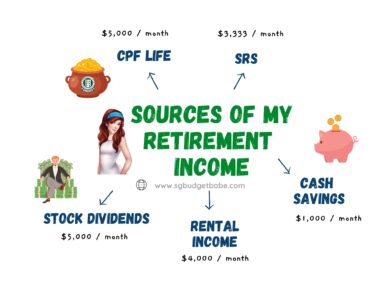Yesterday, Mothership posted a viral post focusing on SMRT’s huge gains in profits. At a preliminary glance, I immediately thought, “Wah, if this is true, then I better buy into the stock now!”
But then another voice in my head said, “Don’t make the mistake of focusing on the stellar results of one quarter. Check whether such a performance can be sustained before you rush to buy.”
SMRT shares climbed almost 3% within a day after the results were released, but I’m laughing at those who jumped to buy so soon after the announcement instead of doing a further forward analysis to determine whether going in now would be a wise move.
SMRT has never been (and will never be) on my watchlist of stocks. After reading Mothership’s article, I decided to revisit my thesis and investigate if things have indeed turned around for the public transport provider.
TLDR summary: No, and it will probably get worse from here.
 |
| Running away from SMRT’s stock before it falls further in the next few quarters. |
Let me first start off by saying that the main reason why I’m not buying in now is because I believe their recent quarter profits growth are only temporary. Upon studying the business in detail and looking at other factors, I realized a key point that may potentially drive their profits (and thus share price) down further in the future:
SMRT’s expenses are expected to increase.
Here’s why.
1. Rail operations are still in the red, with million-dollar losses.
2. SMRT is grappling with increased costs for maintenance and renewal programmes for its rail network.
With all the highly-publicized train breakdowns, we already know by now that SMRT has a lot of improvement works to do, especially on its third rail system.
The management team has already stated that they anticipate further increases in operating expenses, partly due to maintenance and renewal programmes for the rail network.
3. Higher manpower cost will continue to erode profits.
4. SMRT is becoming more and more in debt.
Discounting the nature of debt in their business, will you invest in a company with increasing debt? I certainly wouldn’t.

5. Steadily decreasing cash and equivalents.
Everyone likes a cash-rich company, and good free cashflows are one of the primary requirements experienced investors look out for in a company before they put in their money. But in Q1, SMRT registered a sharp drop from $207 million to $131 million in its cash and equivalents, whereas its latest quarter stands at an even lower $126 million.
6. Contrary to popular belief, low fuel prices doesn’t automatically translate into more profits.
“But BB, the lower oil / fuel prices today should benefit SMRT in the future!”
7. Neither does higher fares.
8. SMRT is not the only public transport provider.
SBS Transit has upped its ante from just being a bus service provider to winning the right to operate the North East Line and the Downtown Line, winning both contracts away from SMRT and breaking its monopoly in the train industry.
SMRT has even admitted that
they expect the new Downtown Line 2 to reduce their revenue even further. Its CFO estimates this to be a $1 million loss in the fourth quarter, with its impact divided as 80% on MRT revenue and 20% on bus revenue.
I was confused about the bus part, until a taxi driver told me about how folks from Bukit Panjang used to take bus services to get to work in CBD, but are now opting to take the train to Newton and complete the rest of the journey by bus instead.
9. SMRT’s 845% increase in bus operating profits is unlikely to sustain.
Although SMRT’s bus segment vastly improved and generated huge profits recently for the company, please do not be fooled into thinking that such a performance will be sustained.
10. Their 500% increase in taxi profits might drop as well.
SMRT’s CFO has already stated that their taxi business has been adversely affected by ride-hailing apps like Uber and GrabTaxi, as its
hired out rate of its taxi fleet has dipped 2% by last December. With GrabCar and Uber Exec, many people who own cars have been signing up as private drivers to earn extra income. One of my friends even does it for a full-time living. There is no need to rent a SMRT or ComfortDelgro taxi anymore.
My main gripe about the Mothership article is that it appears misleading to a novice investor as it presents SMRT in a highly favourable light, especially when one reads sentences like these:
Immediate thought of a novice investor: WOOHOO DIVIDENDS! Time to buy SMRT stocks now so I can benefit from their higher dividends in the future!
I wonder if all the retail investors who jumped to buy yesterday considered all of these before buying?
Well, I guess they will realize their mistake when the share price drops further over the next few quarters, especially after August 2016 when the new bus providers enter.
As a BB reader, I hope you’re now well aware of the cons you need to factor in before you buy! Still think SMRT is a good stock?
With love,
(a very tired) Budget Babe




















7 comments
Well written analysis of SMRT!
Bought in at 1.42
The nxt quarter of SMRT financial result will roughly show how huge the impact DTL have on its train revenue.
Congrats! Today 1.66, you're sitting on profits. I'm guessing a crash on this stock is imminent, so I would sell now if I were you.
Thank you. I bought more from 1.50 to 1.55. And yes, I sold them at 1.62 to 1.66. I do not agree on the imminent crash but needed the funds for other stocks, especially with the decent returns.
Bought DBS at $13 to $14 since CNY week, some Keppel & oil n gas, and also significant amount of a food company.
This comment has been removed by a blog administrator.
This comment has been removed by a blog administrator.
Comments are closed.